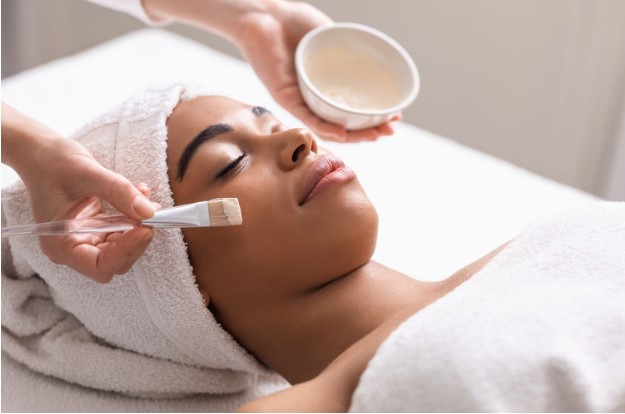
Chemical peel treatment is a widely used dermatological procedure designed to improve the appearance and health of the skin. By applying a chemical solution, the outer layers of the skin are exfoliated, revealing fresher, smoother, and more even-toned skin underneath. Chemical peels are commonly used to address a variety of skin concerns, including acne, hyperpigmentation, uneven skin texture, sun damage, fine lines, and scarring. Choosing the right type of chemical peel is essential to achieving the desired results, as different peels penetrate the skin to varying depths. In this blog, we will explore the different types of chemical peel treatments and help you determine which one may be suitable for your skin type and concerns.
Superficial (Light) Chemical Peels
Superficial chemical peels, also referred to as light peels, are the mildest form of chemical exfoliation. They primarily target the epidermis, the outermost layer of the skin, and are typically composed of alpha hydroxy acids (AHAs) like glycolic acid, lactic acid, or beta hydroxy acids (BHAs) such as salicylic acid. These acids gently dissolve dead skin cells, stimulating cell turnover without causing significant downtime.
Benefits of Superficial Peels
Superficial peels offer a range of benefits for individuals with minor skin concerns:
- Acne Treatment: Salicylic acid peels are particularly effective in reducing mild to moderate acne. They penetrate pores to remove excess oil and debris, helping prevent future breakouts.
- Hyperpigmentation: AHAs are known for their ability to lighten dark spots, age spots, and uneven skin tone. Regular sessions can gradually improve the overall complexion.
- Fine Lines and Texture: Superficial peels can smooth out fine lines and rough skin texture, promoting a healthier and more youthful appearance.
- Skin Brightening: By removing the outer layer of dead skin cells, superficial peels provide a radiant and refreshed look.
Ideal Candidates for Superficial Peels
Superficial chemical peels are suitable for individuals with sensitive skin, minor pigmentation issues, mild acne, or those who are new to chemical peel treatment. These peels require minimal downtime, and most patients can resume normal activities immediately, making them an excellent choice for people with busy lifestyles.
Medium Chemical Peels
Medium-depth chemical peels penetrate deeper into the skin, reaching the lower part of the epidermis and sometimes the upper dermis. Trichloroacetic acid (TCA) is commonly used in medium peels, and they are designed to address more pronounced skin concerns than superficial peels.
Benefits of Medium Peels
Medium chemical peels offer significant improvements for various skin issues:
- Acne Scars: Medium-depth peels are effective in reducing moderate acne scars by promoting collagen production and improving skin texture.
- Sun Damage and Pigmentation: These peels can effectively treat sun-induced dark spots, age spots, and uneven skin pigmentation.
- Wrinkles and Fine Lines: Medium peels help reduce moderate wrinkles around the eyes, mouth, and forehead, offering more noticeable anti-aging benefits.
- Skin Rejuvenation: By promoting deeper exfoliation, medium peels stimulate skin regeneration and improve overall tone and firmness.
Ideal Candidates for Medium Peels
Individuals with more pronounced skin concerns, such as moderate wrinkles, pigmentation issues, or scarring, may benefit from medium peels. Unlike superficial peels, medium peels require a few days to a week of downtime. Redness, peeling, and swelling are common during the healing process, so planning the procedure around your schedule is important.
Deep Chemical Peels
Deep chemical peels are the most intensive type of chemical exfoliation, designed to penetrate the full thickness of the epidermis and reach the dermis. Phenol is the most commonly used agent for deep peels. These peels provide dramatic results but come with higher risks and longer recovery times.
Benefits of Deep Peels
Deep peels are used for severe skin concerns and offer the following advantages:
- Severe Wrinkles: Deep peels can significantly reduce deep lines and wrinkles, especially around the eyes, mouth, and forehead.
- Scarring: Effective for deep acne scars and other types of scarring, deep peels promote extensive collagen remodeling.
- Sun Damage: Deep peels can remove extensive sun-induced pigmentation and restore a more even skin tone.
- Skin Tightening: Because deep peels stimulate collagen production, they provide a tightening effect and improve skin elasticity.
Ideal Candidates for Deep Peels
Deep chemical peels are recommended for individuals with severe skin damage, pronounced wrinkles, or significant scarring. These procedures require a substantial recovery period, often lasting two to four weeks, during which strict post-treatment care is essential. Due to their intensity, deep peels are typically performed under medical supervision, and patients should consult with a qualified dermatologist before undergoing treatment.
Factors to Consider When Choosing a Chemical Peel
Selecting the right chemical peel treatment depends on several factors:
- Skin Type and Sensitivity: Individuals with sensitive skin may benefit from superficial peels, while those with thicker skin and deeper concerns may require medium or deep peels.
- Skin Concerns: Identify your primary skin concerns—acne, pigmentation, wrinkles, or scarring—to determine the most appropriate peel type.
- Downtime and Recovery: Consider how much downtime you can accommodate, as medium and deep peels require more recovery time.
- Medical History: Certain conditions, such as active infections, keloid formation, or recent facial procedures, may influence your suitability for chemical peels.
Consulting with a qualified dermatologist is crucial to assess your skin and recommend the most appropriate treatment plan.
Conclusion
Chemical peel treatment offers a versatile solution for a wide range of skin concerns, from mild fine lines and acne to severe scarring and sun damage. By understanding the differences between superficial, medium, and deep peels, you can make an informed decision about which treatment best meets your needs. Each type of peel offers unique benefits and requires different levels of downtime, making professional consultation essential. For personalized guidance and effective solutions, a pimple treatment dermatologist can help you determine the most suitable chemical peel and create a comprehensive skincare plan tailored to your goals.